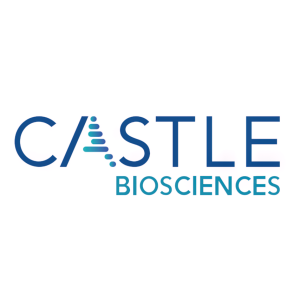Castle Biosciences Presents Clinical Use Scenarios for Its Diagnostic Gene Expression Profile Tests at Maui Derm NP+PA Fall 2022 Conference
Castle Biosciences (Nasdaq: CSTL) presented a framework for its diagnostic gene expression profile tests, MyPath Melanoma and DiffDx-Melanoma, aimed at enhancing clinical decision-making for melanoma diagnoses during the Maui Derm NP+PA Fall 2022 Conference. The proposed clinical workflow highlights how these tests can reduce diagnostic uncertainty, particularly in distinguishing between benign and malignant melanocytic lesions. The tests demonstrated a significant reduction in unnecessary excisions for benign results and increased visits for malignant cases, thus offering personalized treatment plans.
- MyPath Melanoma and DiffDx-Melanoma tests can reduce excisions by 76.7%-80.5% for benign results.
- 75% increase in excisions for malignant test results indicates a more aggressive treatment approach.
- 74.1% of dermatologists reported reducing office visits for benign results, leading to efficient resource use.
- None.
Insights
Analyzing...
Clinical workflow for MyPath® Melanoma and DiffDx®-Melanoma provides a framework for use of the tests in clinical practice to reduce uncertainty in diagnoses
MyPath Melanoma and DiffDx-Melanoma are Castle’s diagnostic GEP tests designed to provide objective, accurate results to aid in the diagnosis of ambiguous melanocytic lesions. The tests can provide clinically actionable information to help guide and potentially increase confidence in a diagnosis, if any uncertainty or discordance exists, to help clinicians deliver more informed patient management plans and provide their patients with more appropriate and individualized care.
“Using diagnostic GEP testing in clinical practice to alleviate ambiguous diagnoses, in terms of whether a lesion is benign or malignant melanoma, can have a significant impact on a patient’s overall treatment plan,” said
The poster, titled “Clinical Utility and a Guide for Using Gene Expression Profile Ancillary Diagnostic Testing for Cutaneous Melanocytic Neoplasms” and available here, provides a proposed post-biopsy clinical workflow for the use of Castle’s diagnostic GEP tests to achieve more personalized management and treatment plans compared to diagnoses based on histopathology alone. Additionally, the poster shares impactful data demonstrating how benign and malignant diagnostic GEP test results can alter patient management plans, including:
-
a
76.7% -80.5% reduction in excisions for patients with benign test results, and a75% increase in excisions for patients with malignant results; and -
74.1% of dermatologists reducing office visits for patients with benign test results, and95.2% of dermatologists increasing office visits for patients with malignant results.
About MyPath® Melanoma and DiffDx®-Melanoma
MyPath Melanoma and DiffDx-Melanoma are Castle’s two gene expression profile tests designed to provide an accurate, objective result to aid dermatopathologists and dermatologists in characterizing difficult-to-diagnose melanocytic lesions. Of the approximately two million suspicious pigmented lesions biopsied annually in the
More information about Castle’s tests can be found at www.CastleTestInfo.com.
About
Castle’s current portfolio consists of tests for skin cancers, uveal melanoma, Barrett’s esophagus and mental health conditions. Additionally, the Company has active research and development programs for tests in other diseases with high clinical need, including its test in development to predict systemic therapy response in patients with moderate-to-severe psoriasis, atopic dermatitis and related conditions. To learn more, please visit www.CastleBiosciences.com and connect with us on LinkedIn, Facebook, Twitter and Instagram.
DecisionDx-Melanoma, DecisionDx-CMSeq, DecisionDx-SCC, MyPath Melanoma, DiffDx-Melanoma, DecisionDx-UM, DecisionDx-PRAME, DecisionDx-UMSeq, TissueCypher and IDgenetix are trademarks of
Forward-Looking Statements
This press release contains forward-looking statements within the meaning of Section 27A of the Securities Act of 1933, as amended, and Section 21E of the Securities Exchange Act of 1934, as amended, which are subject to the “safe harbor” created by those sections. These forward-looking statements include, but are not limited to, statements concerning: the potential of our diagnostic GEP tests to (i) provide clinically actionable information to help guide and potentially increase confidence in a diagnosis; (ii) have a significant impact on a patient’s overall treatment plan; and (iii) potentially increase confidence in clinical diagnoses and ensure the treatment intensity for each patient is better aligned to those diagnoses. The words “can,” “potential” and similar expressions are intended to identify forward-looking statements, although not all forward-looking statements contain these identifying words. We may not actually achieve the plans, intentions or expectations disclosed in our forward-looking statements, and you should not place undue reliance on our forward-looking statements. Actual results or events could differ materially from the plans, intentions and expectations disclosed in the forward-looking statements that we make. These forward-looking statements involve risks and uncertainties that could cause our actual results to differ materially from those in the forward-looking statements, including, without limitation: subsequent study or trial results and findings may contradict earlier study or trial results and findings or may not support the results obtained in this study, including with respect to the discussion of our diagnostic GEP tests in this press release; actual application of our tests may not provide the aforementioned benefits to patients; and the risks set forth under the heading “Risk Factors” in our Quarterly Report on Form 10-Q for the three months ended
View source version on businesswire.com: https://www.businesswire.com/news/home/20220921005156/en/
Investor Contact:
czuckero@castlebiosciences.com
Media Contact:
amarshall@castlebiosciences.com
Source:







